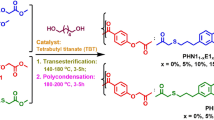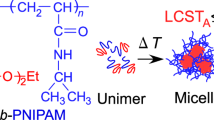Abstract
The mean-square radius of gyration, second virial coefficient and intrinsic viscosity were determined in methanol at 25.0 °C for two types of poly(N,N-diethylacrylamide) (PDEA) samples that were synthesized by radical polymerization in tert-butanol and benzene using azobis(isobutyronitrile) as an initiator. Analyses of these results indicated that the primary structure of both PDEA samples was linear. The cloud points of the two PDEA samples were also determined in aqueous solutions. For the two types of PDEA samples, the cloud point decreased as the weight-average molecular weight Mw of the sample increased, which is in contrast to previously reported results for poly(N-isopropylacrylamide) (PNIPA) samples, even though those samples have the same hydrophobic chain-end groups. In addition, the cloud-point curve of each PDEA sample has a critical point, which has not been previously reported for PNIPA. The critical point shifted to the upper right with decreasing Mw, as predicted by conventional polymer solution thermodynamics. Therefore, the aqueous PDEA solutions exhibited typical phase behavior that is consistent with the lower critical solution temperature type, which is substantially different from that observed for aqueous PNIPA solutions.
Similar content being viewed by others
Log in or create a free account to read this content
Gain free access to this article, as well as selected content from this journal and more on nature.com
or
References
Koningsveld, R., Stockmayer, W. H. & Nies, E. Polymer Phase Diagrams, (Oxford Univ. Press, New York, NY, USA, 2001).
Schild, H. G. Poly(N-isopropylacrylamide): experiment, theory, and application. Prog. Polym. Sci. 17, 163–249 (1992).
Kikuchi, A. & Okano, T. Pulsatile drug release control using hydrogels. Adv. Drug Deliv. Rev. 54, 53–77 (2002).
Gil, E. S. & Hudson, S. M. Stimuli-responsive polymers and their bioconjugates. Prog. Polym. Sci. 29, 1173–1222 (2004).
Kawaguchi, T., Kojima, Y., Osa, M. & Yoshizaki, T. Cloud points in aqueous poly(N-isopropylacrylamide) solutions. Polym. J. 40, 455–459 (2008).
Kawaguchi, T., Kojima, Y., Osa, M. & Yoshizaki, T. Primary structure of poly(N-isopropylacrylamide) synthesized by radical polymerization. Effects of polymerization solvents. Polym. J. 40, 528–533 (2008).
Kobayashi, K., Yamada, S., Nagaoka, K., Kawaguchi, T., Osa, M. & Yoshizaki, T. Characterization of linear poly(N-isopropylacrylamide) and cloud points in its aqueous solutions. Polym. J. 41, 416–424 (2009).
Kawaguchi, T., Kobayashi, K., Osa, M. & Yoshizaki, T. Is a ‘cloud-point curve’ in aqueous poly(N-isopropylacrylamide) solution binodal? J. Phys. Chem. B 113, 5440–5447 (2009).
Ise, T., Nagaoka, K., Osa, M. & Yoshizaki, T. Cloud points in aqueous solutions of poly(N-isopropylacrylamide) synthesized by aqueous redox polymerization. Polym. J. 43, 164–170 (2011).
Flory, P. J. Principles of Polymer Chemistry, (Cornell Univ. Press, Ithaca, NY, USA, 1953).
Tong, Z., Zeng, F. & Zheng, X. Inverse molecular weight dependence of cloud points for aqueous poly(N-isopropylacrylamide) solutions. Macromolecules 32, 4488–4490 (1999).
Lessard, D. G., Ousalem, M. & Zhu, X. X. Effect of the molecular weight on the lower critical solution temperature of poly(N,N-diethylacrylamide) in aqueous solutions. Can. J. Chem. 79, 1870–1874 (2001).
Freitag, R., Baltes, T. & Eggert, M. A comparison of thermoreactive water-soluble poly-N,N-diethylacrylamide prepared by anionic and by group transfer polymerization. J. Polym. Sci. A Polym. Chem. 32, 3019–3030 (1994).
Kobayashi, M., Okuyama, S., Ishizone, T. & Nakahama, S. Stereospecific anionic polymerization of N,N-diethylacrylamides. Macromolecules 32, 6466–6477 (1999).
Kobayashi, M., Ishizone, T. & Nakahama, S. Synthesis of highly isotactic poly(N,N-diethylacrylamide) by anionic polymerization with Grignard reagents and diethylzinc. J. Polym. Sci. A Polym. Chem. 38, 4677–4685 (2000).
Katsumoto, Y., Etoh, Y. & Shimoda, N. Phase diagrams of stereocontrolled poly(N,N-diethylacrylamide) in water. Macromolecules 43, 3120–3121 (2010).
Itakura, M., Inomata, K. & Nose, T. Aggregation behavior of poly(N,N-diethylacrylamide) in aqueous solution. Polymer 41, 8681–8687 (2000).
Maeda, Y., Nakamura, T. & Ikeda, I. Change in solvation of poly(N,N-diethylacrylamide) during phase transition in aqueous solutions as observed by IR spectroscopy. Macromolecules 35, 10172–10177 (2002).
Berry, G. C. Thermodynamic and conformational properties of polystyrene. I. Light-scattering studies on dilute solutions of linear polystyrenes. J. Chem. Phys. 44, 4550–4564 (1966).
Johnson, B. L. & Smith, J. in Light Scattering from Polymer Solutions (ed. Huglin, M. B.) Ch. 2 (Academic, London, UK, 1972).
Osa, M., Shiraki, H., Morinaga, U. & Yoshizaki, T. Effects of surfactants on cloud points in aqueous poly(N-isopropylacrylamide) solutions. Polym. J. 45, 681–684 (2013).
Yamakawa, H. Modern Theory of Polymer Solutions, (Harper & Row, New York, NY, USA, 1971).
Yamakawa, H. Helical Wormlike Chains in Polymer Solutions, (Springer, Berlin, Germany, 1997).
Nakamura, Y. Dilute solution properties of star and comb polymers. Kobunshi Ronbunshu 57, 530–541 (2000).
Abe, F., Einaga, Y. & Yamakawa, H. Excluded-volume effects on the intrinsic viscosity of oligomers and polymers of styrene and isobutylene. Macromolecules 26, 1891–1897 (1993).
Author information
Authors and Affiliations
Corresponding author
Ethics declarations
Competing interests
The authors declare no conflict of interest.
Additional information
Supplementary Information accompanies the paper on Polymer Journal website
Supplementary information
Rights and permissions
About this article
Cite this article
Watanabe, R., Takaseki, K., Katsumata, M. et al. Characterization of poly(N,N-diethylacrylamide) and cloud points in its aqueous solutions. Polym J 48, 621–628 (2016). https://doi.org/10.1038/pj.2015.120
Received:
Revised:
Accepted:
Published:
Issue date:
DOI: https://doi.org/10.1038/pj.2015.120
This article is cited by
-
Poly(N,N-bis(2-methoxyethyl)acrylamide), a thermoresponsive non-ionic polymer combining the amide and the ethyleneglycolether motifs
Colloid and Polymer Science (2021)
-
Dissolution of a transparent cross-linked polymer monolith in water by oxidative de-crosslinking
Polymer Journal (2019)



